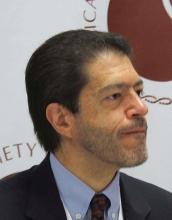and older adult patients, a trend that has been going on for decades. But clinicians and researchers are getting serious about an important question: Why?
“This is a very heterogeneous group of disorders,” Rabi Hanna, MD, a pediatric hematologist and oncologist, and director of pediatric bone marrow transplantation at Cleveland Clinic Children’s Hospital, Ohio, said in an interview.
He is referring to the cancers that affect adolescents and young adults (AYAs), who are broadly defined as patients aged 15-39 years.
“A few cancers, such as [acute lymphoblastic leukemia], are more common in children, and others, such as breast cancer, are more common in adults; biology may be different in the adolescent and young adult patients, which may lead to different outcomes,” Dr. Hanna said.
In addition, the psychosocial needs in this age group differ vastly from those of other groups, he said.
“Many of these patients are in college or have just started their families, so we have to pay attention more to financial toxicities and fertility, for example,” he said.
Another factor that likely contributes to the disparities between AYAs and other populations with cancer is the relative lack of clinical trial involvement among AYAs. That’s a point on which Dr. Hanna and many other experts agree.
A recent series of articles published in Blood addressed these and other issues, including whether AYAs with ALL or aggressive B-cell non-Hodgkin lymphomas (NHLs) should be treated as children or adults, treatment strategies for those with acute myeloid leukemias, management of Hodgkin lymphoma, and psychosocial challenges and health-related quality of life (QOL) of AYAs with hematologic malignancies.
“Hematological malignancies occurring in AYAs represent a unique challenge because of their special biological features and distinctive therapeutic requirements, as well as the unique medical, social, and psychological characteristics of this patient population,” Jorge Cortes, MD, an assistant editor for Blood, wrote in an introduction to the series.
“Unfortunately, not much has been done to explore unique molecular and biological features of AYA hematologic malignancies. The discussion on the management of AYAs frequently centers on whether these patients should be treated in a pediatric setting or an adult setting, or with regimens designed for children or for adults. Clinical trials specifically designed for AYAs are scanty,” noted Dr. Cortes, who directs the chronic myeloid leukemia (CML) and acute myeloid leukemia programs (AML) at the University of Texas MD Anderson Cancer Center, Houston.
Treatment approach and setting
In the Blood article on ALL in AYAs, Nicolas Boissel, MD, and André Baruchel, MD, note that the use of “fully pediatric protocols” in patients aged 15-20 years is supported by numerous studies, and that in young adults, evidence increasingly supports “pediatric-inspired or even fully pediatric approaches” as they have been shown to dramatically improve outcomes, with long-term survival rates nearing 70% (2018;132:351-61).



